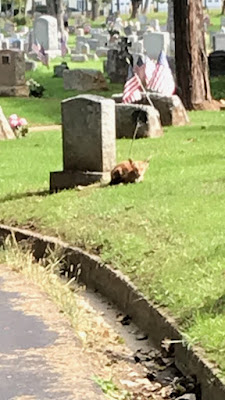The officer inspected the tree, peering inside with a flashlight, and confirmed that this was a likely fox hangout although probably not the den.
Next we went to the northeast corner of Cedar Park, where a fox was most recently seen coming across the road from the transfer station. It was this general area where the mangy fox was photographed on September 23 and where it was found dead the next day.
Along the way, we met up with another fox watcher and several members of the DPW cemetery crew. The officer was interested not only in fox sightings but the observed behavior of the foxes. None of us had witnessed anything that we interpreted as aggression, but we did attest that the fox (or foxes) we'd observed didn't seem very fearful of humans. This behavior could be attributed simply to the fact that the foxes live in an urban area and have grown accustomed to seeing humans. In my experience last Saturday, when I was trying to get close enough to the fox to get a good picture, the fox only darted away when it caught sight of Joey. As the DEC officer pointed out, the only natural enemies of foxes in an urban setting are domestic dogs.
COPYRIGHT 2018 CAROLE OSTERINK




No comments:
Post a Comment